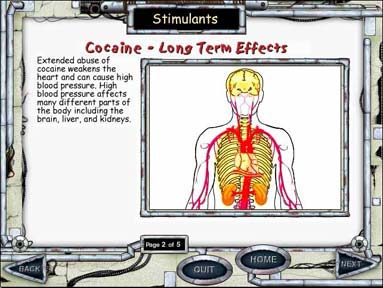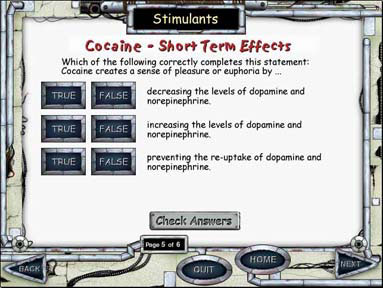
 A CD-ROM-based game called "The Science of Drugs" uses text, graphics, and animation to teach children how their brains and bodies work and how abused drugs, such as cocaine, affect those processes. Children then apply this information in an interactive board game where they answer questions about how drugs affect the brain.
A CD-ROM-based game called "The Science of Drugs" uses text, graphics, and animation to teach children how their brains and bodies work and how abused drugs, such as cocaine, affect those processes. Children then apply this information in an interactive board game where they answer questions about how drugs affect the brain.What do a computer-based drug abuse prevention program, a CD-ROM game designed to teach children about the effects of abused drugs, and devices that can block pain without medication have in common? All are among the innovative products and programs showcased at a NIDA meeting last fall. At the meeting, companies that have received NIDA Small Business Innovation Research (SBIR) and Small Business Technology Transfer (STTR) awards discussed their progress on new drug abuse-related products. (See "About the SBIR and STTR Programs,")
"This meeting demonstrates the diversity of products fostered by these programs," said Dr. Cathrine Sasek, who coordinates NIDA's SBIR and STTR Programs. "By highlighting these products, we hope to spur increased use of small business grants to meet NIDA's research needs in all program areas." Products presented at the meeting include the following:
 Lightweight, wireless devices, such as the one shown on the cyclist's leg, can be applied to specific parts of the to control pain. The devices deliver electrical pulses in a variety of patterns to provide relief from different types of acute and episodic pain, including pain from wounds, joint and muscle injuries, and surgery.
Lightweight, wireless devices, such as the one shown on the cyclist's leg, can be applied to specific parts of the to control pain. The devices deliver electrical pulses in a variety of patterns to provide relief from different types of acute and episodic pain, including pain from wounds, joint and muscle injuries, and surgery.- The Science of Drugs, a CD-ROM-Based Game
"We wanted to engage middle school students in the process of learning how their brains and bodies work and how abused drugs affect those processes," said Robert Hone of Red Hill Studios in Sausalito, California, in describing a children's CD-ROM-based game being developed with SBIR funds. The game will have seven units that use text, graphics, and animation to provide an overview of human physiology, information on different abused drugs, and a review of the effects of drugs and addiction. Each educational unit will be linked to an interactive board game that reinforces the information presented by challenging students to answer questions about how drugs affect the brain. A prototype program on stimulants has been shown to actively engage the attention of middle school students from a broad range of socioeconomic backgrounds and substantially increase their knowledge about the drugs. - Computer-Based Drug Abuse Prevention
"Among the many challenges schools face in implementing research-based drug abuse prevention programs are the costs and time required to train teachers to ensure that programs are delivered accurately," said Dr. Warren Bickel of the University of Vermont in Burlington. Under an STTR grant, the university is working with its business partner, HealthSim, Inc., also in Burlington, to meet such challenges with an interactive, computer-based drug abuse prevention program for adolescents. The multimedia program incorporates drug abuse prevention components that scientific research has shown can prevent adolescents from beginning to use drugs. Training in drug refusal, general decision-making, and social skills is delivered through interactive computer instruction and video simulations. The program is designed to reduce teacher training time, assure program fidelity, and provide an engaging educational experience for students. - Noninvasive Pain Relief
Stephen Michelson and Jeffrey Mannheimer of Cyclotec Medical Industries, Inc., in Lauderhill, Florida, demonstrated several devices that can be applied to specific parts of the body to provide noninvasive, nonmedicinal pain control. The devices relieve pain by electrically stimulating nerves through the skin, a technology known as transcutaneous electrical nerve stimulation (TENS). The company's slim, lightweight, and wireless TENS devices deliver electrical pulses in a variety of patterns that provide relief from different types of acute and episodic pain, including pain from wounds, joint and muscle injuries, and surgery. Initial clinical testing indicates that using these devices as part of a comprehensive therapeutic regimen can enhance recovery from surgery by relieving postoperative discomfort. Devices that can be placed underneath bandages or into splints, remote-controlled units, and disposable bandage units are under development.
Also showcased at the meeting were:
- An integrated suite of drug abuse prevention services being developed by Tanglewood Research in Tanglewood, North Carolina. The suite includes elementary, middle, and high school drug abuse prevention programs; an educational course for teachers on prevention principles; and an online evaluation program that will enable schools and community service providers to conduct ongoing assessments of research-based drug abuse prevention programs.
- A hand-held computerized medication dispenser being developed by Integra Innovations, Inc., of Golden, Colorado. The device can be programmed to inform patients about their prescription medications and remind them when to take them, dispense the medications, and keep track of when they are taken. The device has the potential to improve compliance with complex medication regimens for a wide range of chronic diseases.
- A program for training police officers to use rapid drug-testing devices to detect illegal drug use by motorists, being developed by the Walsh Group in Bethesda, Maryland. During a 4-month study, Tampa, Florida, police officers who were trained with a prototype program successfully collected and analyzed urine specimens from motorists who failed a standard field sobriety test. A self-administered CD-ROM version of the training program will be evaluated with another police department.
